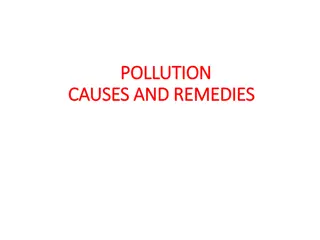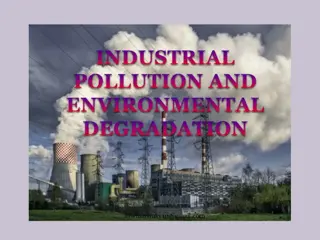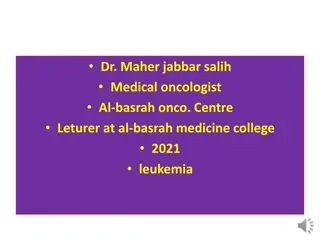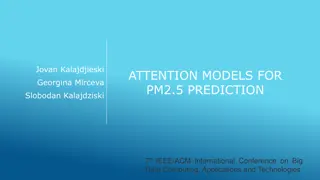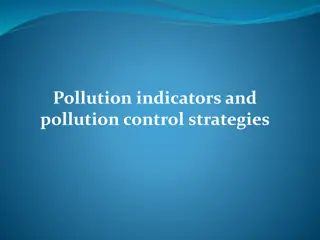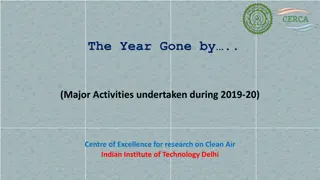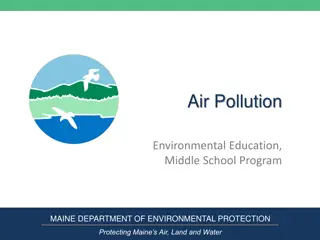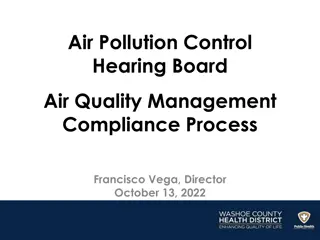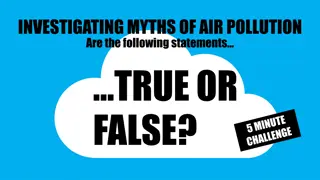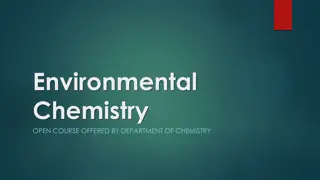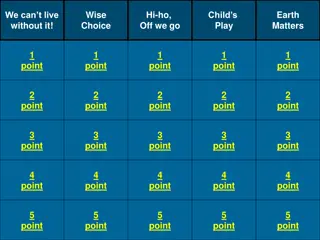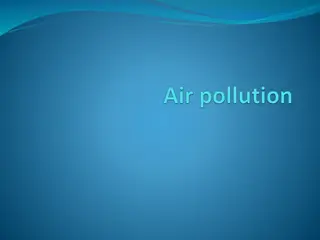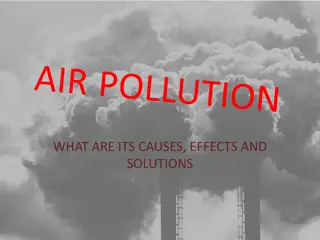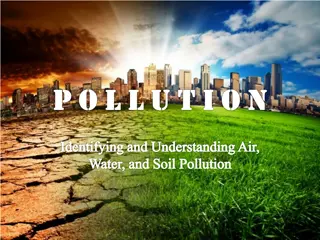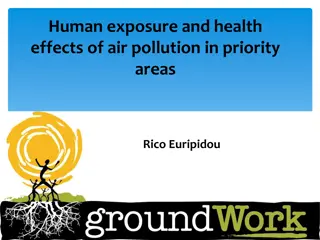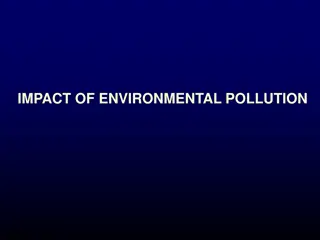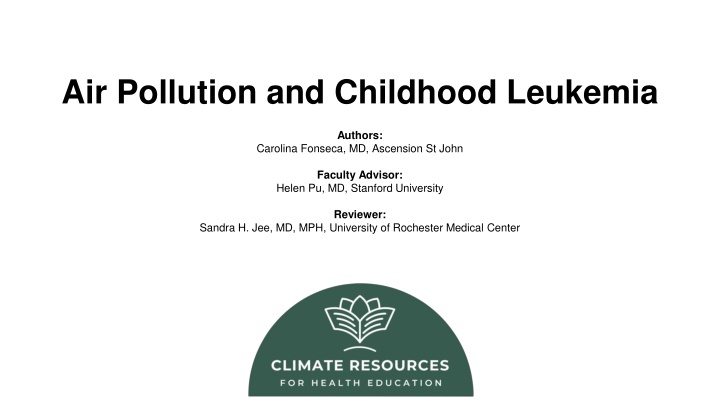
Air Pollution and Childhood Leukemia Study: Impact on Children's Health
Explore the correlation between air pollution and childhood leukemia, exacerbated by climate change. Learn about the risks, symptoms, and socioeconomic factors involved. A case study highlights a 5-year-old girl's presentation with leukemia symptoms. Discover how changing climate conditions intensify air pollution's harmful effects and carcinogenic potential on children's health.
Download Presentation

Please find below an Image/Link to download the presentation.
The content on the website is provided AS IS for your information and personal use only. It may not be sold, licensed, or shared on other websites without obtaining consent from the author. If you encounter any issues during the download, it is possible that the publisher has removed the file from their server.
You are allowed to download the files provided on this website for personal or commercial use, subject to the condition that they are used lawfully. All files are the property of their respective owners.
The content on the website is provided AS IS for your information and personal use only. It may not be sold, licensed, or shared on other websites without obtaining consent from the author.
E N D
Presentation Transcript
Air Pollution and Childhood Leukemia Authors: Carolina Fonseca, MD, Ascension St John Faculty Advisor: Helen Pu, MD, Stanford University Reviewer: Sandra H. Jee, MD, MPH, University of Rochester Medical Center
Learning Objectives: 1. Explain how climate-mediated exposure to air pollution is worsening due to global climate change. 2. Understand how exposure to air pollution increases the risk of childhood leukemia. 3. Recognize the signs and symptoms of leukemia in a pediatric population. 4. Recognize that low socioeconomic status and certain geographic areas are risk factors that may contribute to increased risk of childhood leukemia under warming conditions.
Case Study 5 year old girl presents to her pediatrician s office for fatigue. Her parents report that she has had a hard time keeping up with her friends for the past month. They have also recently noticed easy bruising after minor bumps. At night her parents have noticed that she feels warm and noticed sweating but they haven t been able to take a temperature. She was previously healthy, no daily medications, no allergies , no hospitalizations or surgeries. Up to date on immunizations. Social Hx: Lives in an apartment in Fresno, California, with her parents and younger brother. Loves to play outside and started kindergarten this year. Parents are struggling financially and avoid using air conditioner due to cost of electricity. Family Hx: no family history of cancer. Parents are immigrants, young and healthy. Maternal grandmother has diabetes.
Case Study Physical Exam: Temp: 38C HR: 118 RR: 16 Pulse Ox: 98% on Room air On exam you notice dark circles under the eyes, bruises of different ages on bilateral shins as well as petechiae on her chest. It does not appear to be in any specific pattern. Her mucous membranes are moist but appear pale. She is playful and interactive but appears to fatigue quickly. Inguinal lymphadenopathy is noted. Lab Results: CBC: WBC: 103,000 Platelets: 35,000 Hgb: 8.5 LDH is elevated
Air pollution in a changing climate and its effect on children s health Higher ambient temperatures are associated with increased air pollution. Increased extreme events such as wildfires contribute to increased air pollution. Children spend more time outdoors than adults and breathe more rapidly Kinney. Current Environmental Health Reports. 2018. Kalashnikov et al., 2022.
Air pollution in a changing climate and its carcinogenic effects Indirect models illustrate how air pollution contributes to cell proliferation and cancer development. Outdoor air pollution contains mutagenic particulate and volatile matter. In addition, mice exposed to industrial ambient air pollution showed higher heritable mutations at tandem-repeat DNA loci. Several studies have found that compounds in air pollution lead to the release of proinflammatory cytokines. Turner et al.CA: A Cancer Journal for Clinicians. 2020. Filippini et al.Environmental Health Perspective. 2019. Hecki et al.Environmental Health Perspective. 2013.
Air pollution in a changing climate and its carcinogenic effects The strongest associations between air pollution and leukemia is from benzene from motorized vehicles. In laboratory studies, benzene has been shown to generate reactive electrophilic metabolites, induce oxidative stress, and DNA damage as well as immunotoxic and hematotoxic effects. Families living within 150m of a major roadway have been shown to have higher risk exposure to these carcinogens and a greater risk of AML. Turner et al.CA: A Cancer Journal for Clinicians. 2020. Filippini et al.Environmental Health Perspective. 2019. Hecki et al.Environmental Health Perspective. 2013.
Air pollution and its effect on childhood cancer Epidemiological literature supports the association between benzene and childhood leukemia, specifically AML. Studies suggest that there is an adverse association between exposure to air pollution during gestation and the development of certain childhood tumors. Turner et al.CA: A Cancer Journal for Clinicians. 2020. Filippini et al.Environmental Health Perspective. 2019. Hecki et al.Environmental Health Perspective. 2013.
Risk Factors that Enhance Vulnerability to Health Consequences of Air Pollution Low income and minority communities tend to experience higher levels of air pollution. Communities in areas that are dependent on outdoor work, such as agriculture, are exposed to air pollution at higher rates and have limited resources to mitigate exposure. Low resource communities also have higher barriers to accessing and obtaining healthcare when illnesses occur. Fernandez-Bou et al. California Natural Resources Agency. 2021. Miranda, Edwards, Keating and Paul. International Journal of Environmental Research and Public Health. 2011.
Implications for Clinical Practice Educate families on effects of poor air quality on health, and teach them strategies to help them decrease their exposure to poor air quality Limited outdoor activity in highly polluted areas/days Reduced near-roadway exposure during commutes Utilization of air quality alert systems Facemasks in prescribed situations Avoid cooking with solid flues and good ventilation in cooking areas Use of portable air cleaners Join other clinicians on advocating for climate and health. - Healthcare without harm - https://medsocietiesforclimatehealth.org
References Anderko, L., Chalupka, S., Du, M. and Hauptman, M., 2022. Climate changes reproductive and children s health: a review of risks, exposures, and impacts. Carlsten, C., Salvi, S., Wong, G. and Chung, K., 2020. Personal strategies to minimise effects of air pollution on respiratory health: advice for providers, patients and the public. European Respiratory Journal, 55(6), p.1902056. Fernandez-Bou, A., Ortiz-Partida, J., Pells, C., Classen-Rodriguez, L., Espinoza, V., Rodriguez-Flores, J. and Medellin- Azuara, J., 2022. San Joaquin Valley Region Report. [online] Energy.ca.gov. Available at: <https://www.energy.ca.gov/sites/default/files/2022-01/CA4_CCA_SJ_Region_Eng_ada.pdf> [Accessed 20 February 2022 Filippini, T., Hatch, E., Rothman, K., Heck, J., Park, A., Crippa, A., Orsini, N. and Vinceti, M., 2019. Association between Outdoor Air Pollution and Childhood Leukemia: A Systematic Review and Dose Response Meta-Analysis. Environmental Health Perspectives, 127(4), p.046002. Heck, J., Wu, J., Lombardi, C., Qiu, J., Meyers, T., Wilhelm, M., Cockburn, M. and Ritz, B., 2013. Childhood Cancer and Traffic-Related Air Pollution Exposure in Pregnancy and Early Life. Environmental Health Perspectives, 121(11-12), pp.1385-1391. Kalashnikov, D., Schnell, J., Abatzoglou, J., Swain, D. and Singh, D., 2022. Increasing co-occurrence of fine particulate matter and ground-level ozone extremes in the western United States. Science Advances, 8(1). Kinney, P., 2018. Interactions of Climate Change, Air Pollution, and Human Health. Current Environmental Health Reports, 5(1), pp.179-186. Miranda, M., Edwards, S., Keating, M. and Paul, C., 2011. Making the Environmental Justice Grade: The Relative Burden of Air Pollution Exposure in the United States. International Journal of Environmental Research and Public Health, 8(6), pp.1755-1771 Turner, M., Andersen, Z., Baccarelli, A., Diver, W., Gapstur, S., Pope, C., Prada, D., Samet, J., Thurston, G. and Cohen, A., 2020. Outdoor air pollution and cancer: An overview of the current evidence and public health recommendations. CA: A Cancer Journal for Clinicians, 70(6), pp.460-479.


